Animals
A Visual Guide to Animals That Look Like Possums
Intrigued by animals resembling possums? Explore unique creatures with prehensile tails and clever survival tactics in this visual guide.
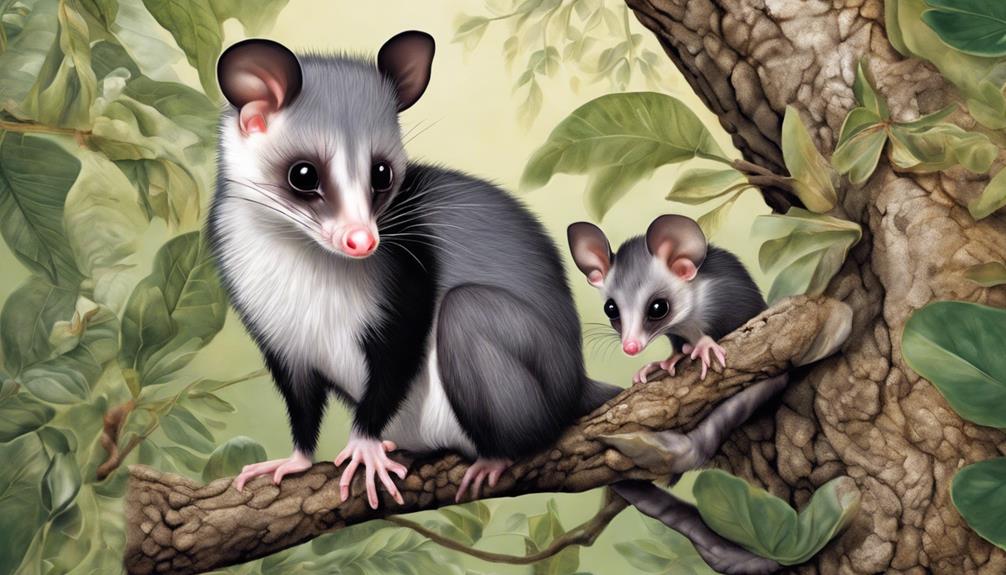
Curious about animals like possums? Some possum-like creatures include the Ringtail Cat and Cuscus, with prehensile tails for climbing. They live in forests and are born underdeveloped, growing in their mother's pouch. Sugar gliders and bushbabies are nocturnal like possums, living in trees and eating various foods like insects. These animals play dead to evade danger, a clever survival tactic. Interested in learning more about animals resembling possums? Discover their habits, habitats, and unique features that make them fascinating creatures.
Key Takeaways
- Sugar gliders possess a gliding membrane for movement in arboreal habitats.
- Bushbabies rely on large eyes for enhanced night vision and are nocturnal.
- Pygmy possums exhibit nocturnal behavior and are omnivorous.
- Ringtail Cats and Cuscus have prehensile tails for navigating forested habitats.
- Virginia opossums play dead as a defense mechanism when threatened.
Possum-Like Animal Species Overview
In investigating the Possum-Like Animal Species Overview, we explore a fascinating array of creatures that bear striking resemblances to possums. Let's start with baby opossums, which are born extremely underdeveloped and are about the size of a honeybee. These tiny creatures instinctively crawl into their mother's pouch, where they continue to develop and grow until they're ready to face the world on their own.
One of the most intriguing behaviors shared by many possum-like animals is the act of playing dead when threatened. This clever tactic can confuse predators, giving these creatures a chance to escape unharmed.
Additionally, the presence of prehensile tails, like those found in the Ringtail Cat and the Cuscus, adds a unique feature to these animals. These tails are incredibly flexible and can be used to grasp onto branches as these creatures move through their forested habitats with agility and grace.
Similarities in Appearance and Behavior
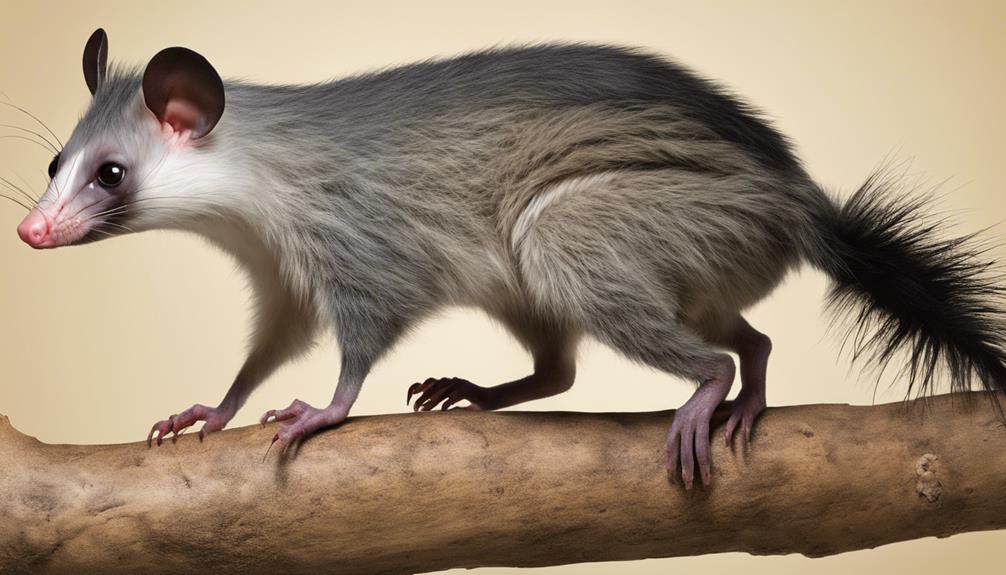
Exploring the striking resemblances in appearance and behavior among animals often mistaken for possums reveals fascinating similarities that extend beyond mere physical traits. In the United States, the Virginia opossum, often referred to simply as the 'opossum', is known for its unique defense mechanism of playing possum when threatened.
Similarly, other animals like sugar gliders, bushbabies, and pygmy possums exhibit nocturnal behavior, preferring arboreal habitats, and maintaining omnivorous diets. Sugar gliders possess a gliding membrane that aids in their movement, while bushbabies rely on their large eyes for enhanced night vision. Pygmy possums, on the other hand, are characterized by their small stature and agile climbing abilities.
Despite these similarities, it's important to recognize that these animals belong to different taxonomic families, each with its distinct evolutionary history. Understanding these distinctions can help prevent confusion and ensure accurate identification of these fascinating creatures in the wild.
Habitat and Geographic Distribution

After examining the similarities in appearance and behavior among animals often mistaken for possums, the focus now shifts to their habitat preferences and geographic distribution.
Possums are primarily found in North and South America, with diverse habitats ranging from forests to urban areas. Their adaptability is evident in their ability to thrive in various environments, including wetlands and grasslands. This wide geographic distribution showcases the versatility of possum species in occupying specific ecological niches.
Some possum species have been introduced to new regions, raising concerns about their impact on local ecosystems. Understanding the habitat preferences and distribution patterns of possums is important for conservation efforts and wildlife management.
In North American habitats, possums play an essential role in the ecosystem by consuming a variety of plant and animal means that they eat. By delving into the habitat and geographic distribution of possums, we can better appreciate their importance in maintaining ecological balance.
Diet and Feeding Habits
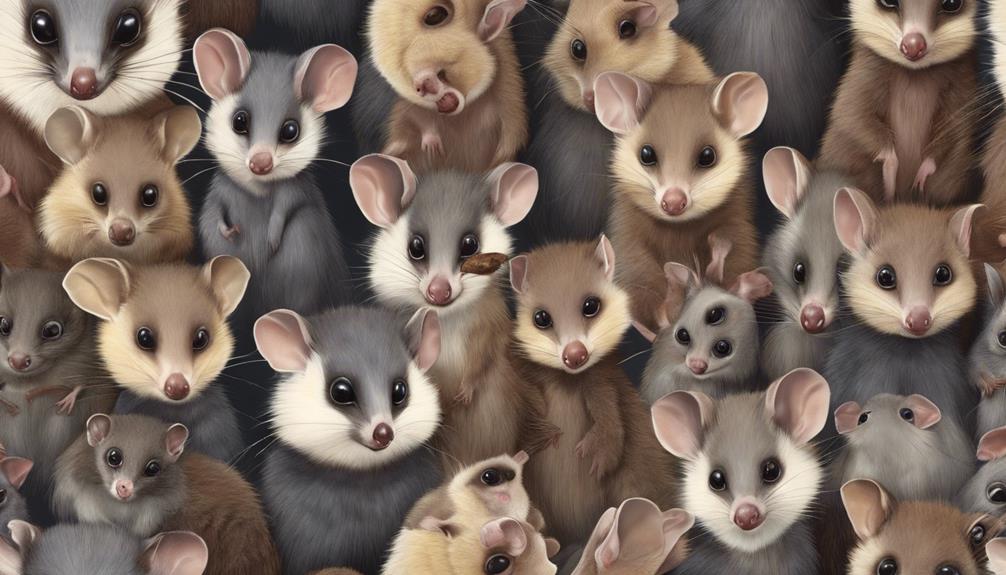
Opossums, being omnivores, have a diverse diet that includes a wide range of plant and animal matter. When it comes to their feeding habits, these unique creatures play an important role in maintaining ecosystem balance. Here are some fascinating aspects of opossums' diet and feeding behaviors:
- Tick Control: Opossums are nature's tick warriors, devouring up to 5,000 ticks in a single season. This helps in keeping tick populations in check and reducing the risk of tick-borne diseases like Lyme Disease.
- Anti-Venom Research: These marsupials are immune to snake venom and often feed on snakes. This immunity makes them valuable in anti-venom research, aiding in understanding and developing treatments for snake bites.
- Ecosystem Balance: Opossums contribute to biodiversity by controlling pest populations. Their role in the food chain helps maintain a healthy balance in various ecosystems.
- Varied Diet: From insects and fruits to frogs, nuts, birds, and carrion, opossums have an eclectic palate that allows them to adapt to different environments and food sources.
- Ecological Impact: By feeding on a variety of organisms, opossums play a unique ecological role that supports the overall health of their habitats.
Unique Adaptations and Survival Strategies
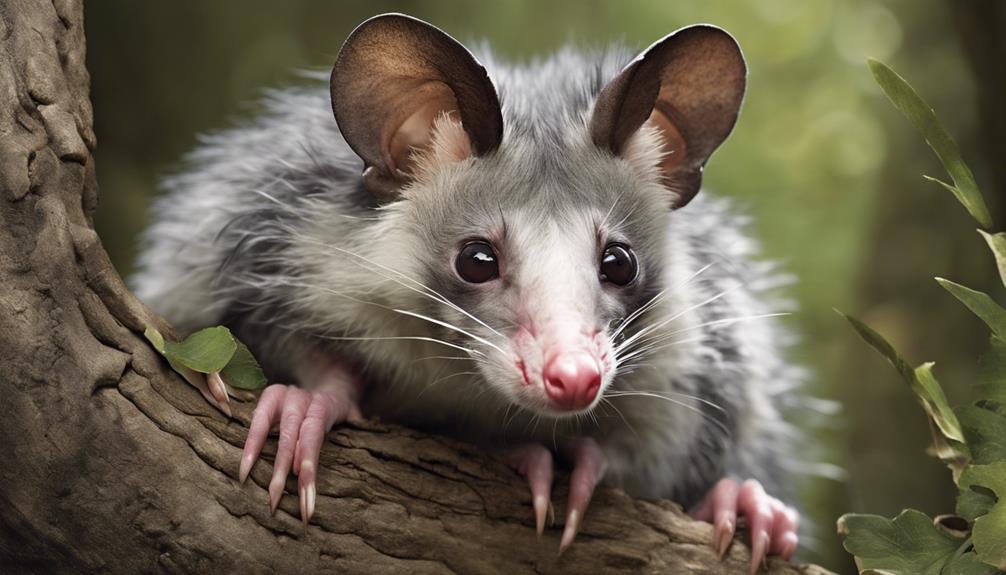
With their unique adaptation of playing dead and emitting a foul odor, possums have developed effective survival strategies to deter predators. When threatened, possums exhibit a behavior known as 'playing possum,' where they appear motionless and unresponsive, fooling predators into thinking they are no longer a threat. Additionally, possums can emit a foul odor similar to that of a dead animal, acting as a defense mechanism to discourage predators from attacking them.
| Survival Strategy | Description |
|---|---|
| Playing Dead | Possums can mimic death for up to 6 hours, tricking predators into believing they are no longer a viable meal. |
| Foul Odor Defense | Emitting a putrid smell similar to that of a decaying animal helps possums deter predators and avoid becoming prey. |
| Immunity to Snake Venom | Possums are immune to snake venom, making them valuable for research on developing anti-venom treatments and showcasing their resilience. |
Not only do possums have these unique survival strategies, but they also have a lower body temperature that reduces the survival rate of viruses and makes them less susceptible to certain diseases. Their immunity to snake venom further highlights their remarkable adaptability in the animal kingdom.
Frequently Asked Questions
What Animal Is Similar to the Opossum?
When thinking about animals similar to the opossum, the Sugar Glider instantly comes to mind. With their shared marsupial status and comparable appearances and behaviors, the Sugar Glider stands out as a close counterpart.
Can Possums Give Diseases to Humans?
Possums rarely transmit diseases to humans. While they can carry illnesses like tuberculosis and leptospirosis, the risk of transfer is low. Basic hygiene, like handwashing after contact, minimizes any potential risks. Avoiding wild possums reduces unlikely transmission.
Why Is Opossum Lifespan so Short?
My answer is that the opossum's short lifespan is a consequence of various factors like predation, disease, and reproductive strategies. Prioritizing rapid reproduction over longevity helps guarantee species survival despite facing environmental pressures and high mortality rates.
Are Possums and Opossums the Same?
Possums and opossums might sound alike, but they're not the same animals. The possums chill in Australia, while opossums roam the Americas. Different continents, different animals, you know?
Conclusion
To sum up, there are over 70 species of animals that resemble possums, each with unique characteristics and adaptations.
One intriguing statistic is that the sugar glider, a possum-like animal, can glide up to 164 feet in a single leap!
These creatures play significant roles in their ecosystems and are captivating to learn about.
Keep exploring the world of wildlife and discover the incredible diversity of possum-like creatures out there.
Dana is our Lead Content Writer, bringing a wealth of knowledge and expertise to our team. With a background deeply rooted in animal studies and a profound love for all creatures, Dana is dedicated to crafting engaging and informative content that resonates with our audience. With Dana at the helm, you can trust that our content is accurate and engaging, catering to the diverse interests of animal enthusiasts everywhere.
Chickens
Achieving High Jumps: How Chickens Can Jump
Curious about how chickens achieve impressive high jumps? Discover the astonishing anatomy and muscles driving their incredible feats in this captivating exploration.
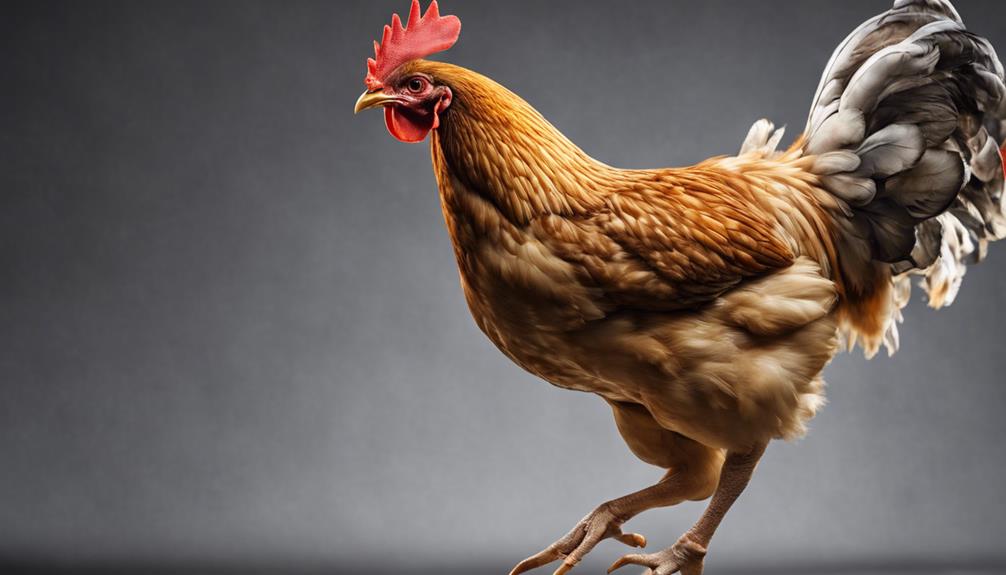
When exploring the realm of chicken anatomy, we uncover a wonder of natural engineering that allows these birds to perform high jumps with accuracy and elegance. Their skeletal structures, primary flight feathers, and strong leg muscles collaborate seamlessly to launch them to impressive heights, demonstrating their inherent strength and agility. This special blend of physical characteristics provides insight into the remarkable capabilities of these feathered animals, prompting us to delve into the intriguing mysteries behind their extraordinary jumping skills.
Key Takeaways
- Chicken leg muscles generate force for high jumps.
- Specialized skeletal structure aids in jumping.
- Primary flight feathers enhance stability.
- Well-developed leg muscles enable obstacle navigation.
- Training programs improve jumping skills effectively.
Chicken Anatomy for Jumping
Chickens' impressive jumping abilities are a result of their powerful leg muscles and specialized skeletal structure. These features work together harmoniously to facilitate their remarkable agility. When examining the anatomy of chickens specifically for jumping, it becomes evident how their bodies are finely tuned for this purpose.
In terms of flight feathers, chickens possess two distinct types that play crucial roles in their jumping prowess. The primary flight feathers, located on the wings, aid in stability and balance during takeoff and landing. These feathers are sturdy and provide the necessary lift for controlled jumps. Conversely, the secondary flight feathers, found on the tail, assist in steering and maneuvering mid-air. The interplay between these two sets of feathers allows chickens to execute precise and controlled jumps with ease.
Understanding the intricate details of chicken anatomy, including the specialized structure of their flight feathers, provides valuable insights into the biomechanics behind their impressive jumping capabilities.
Muscle Strength and Jumping Power
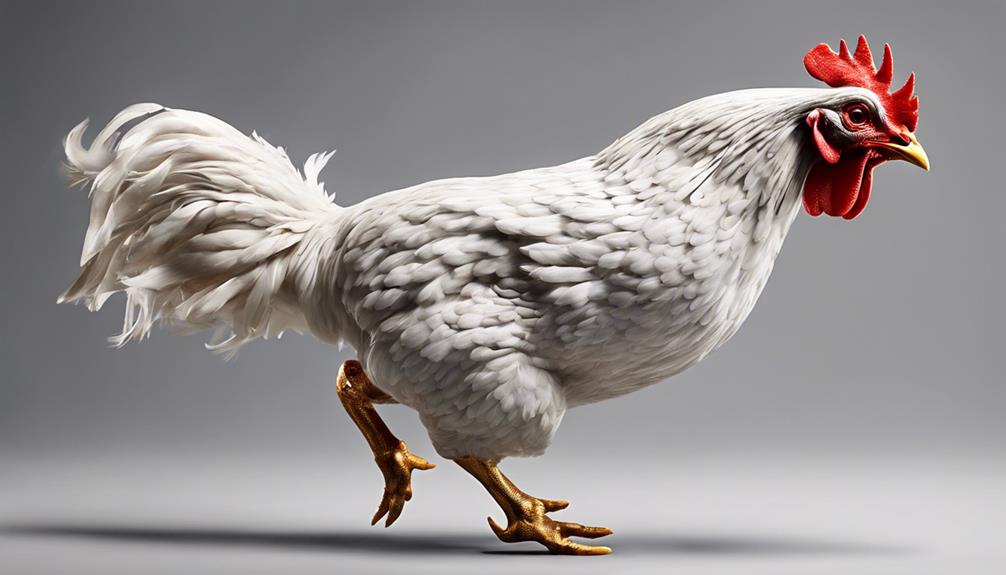
Examining the biomechanics of chicken leg muscles provides valuable insight into the source of their impressive jumping abilities. Chickens heavily rely on the strength of their leg muscles to generate the force required for high jumps. The power needed to propel chickens off the ground and navigate obstacles comes from well-developed leg muscles. Their ability to reach elevated perches is directly linked to the strength and conditioning of these muscles.
| Muscle Strength | Importance |
|---|---|
| Powerful | Generates force for high jumps |
| Well-developed | Enables navigation of obstacles and reaching elevated perches |
| Correlated | Strength and conditioning affect jumping power |
The leg muscles of chickens play a vital role in their jumping prowess. By understanding the biomechanics of these muscles, we gain valuable insights into how chickens achieve such remarkable jumping abilities.
Techniques for Maximum Jump Height
Our research focuses on optimizing techniques for achieving maximum jump height in chickens through a systematic training approach. To enhance jump height effectively, it's crucial to implement a gradual training regimen. By progressively increasing the difficulty of jumps, chickens are continually challenged, leading to improved jumping abilities. Varied jump heights should be incorporated to push the chickens to their limits and encourage them to reach their maximum potential.
Positive reinforcement techniques play a vital role in motivating chickens to achieve higher jumps. Rewarding successful jumps reinforces the desired behavior, making the training process more effective. Additionally, ensuring proper rest intervals between training sessions is essential to prevent fatigue, support muscle recovery, and enable optimal performance during each session.
Close monitoring of the chickens' progress is necessary to track improvement and adjust training techniques accordingly. By carefully analyzing their performance, adjustments can be made to optimize their maximum jump height potential. Through a combination of strategic training methods and attentive supervision, chickens can develop impressive jumping skills.
Training for Improved Jumping Skills
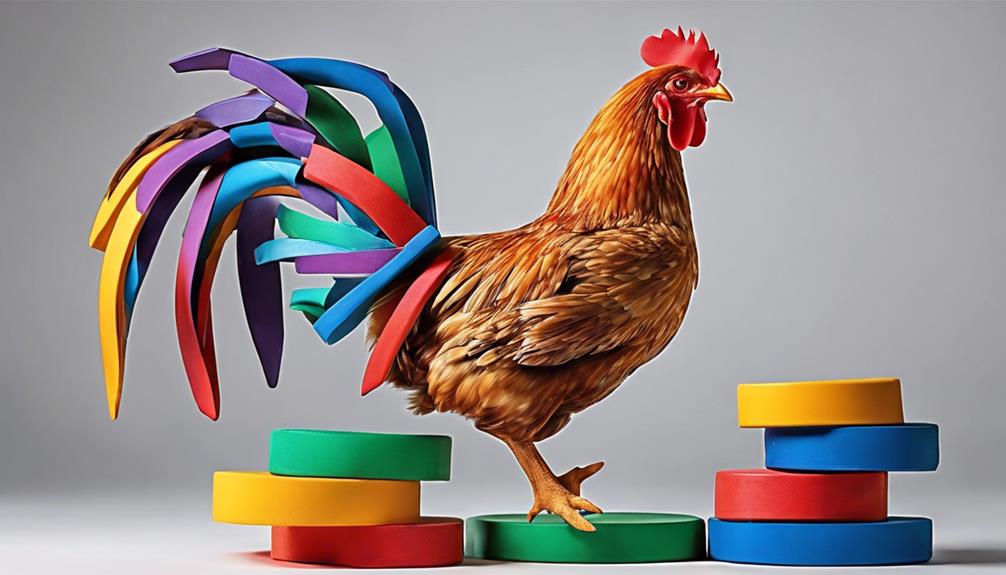
To enhance chickens' jumping skills, a structured training program that begins with foundational jumps and progressively advances in height and complexity is crucial. Training chickens involves starting with basic jumps and gradually increasing the height and intensity of the jumps as they become more proficient.
Incorporating variations like side-to-side jumps can help enhance a chicken's jumping abilities by challenging their coordination and agility. Positive reinforcement plays a vital role in training chickens to jump effectively, as it encourages desired behaviors.
Additionally, allowing proper rest and recovery between training sessions is essential for optimal results in jumping skills development, as it helps prevent fatigue and injuries. Consistent training with patience and encouragement can help chickens excel in their jumping abilities over time, gradually improving their strength and technique.
Comparing Chicken Jumping Abilities
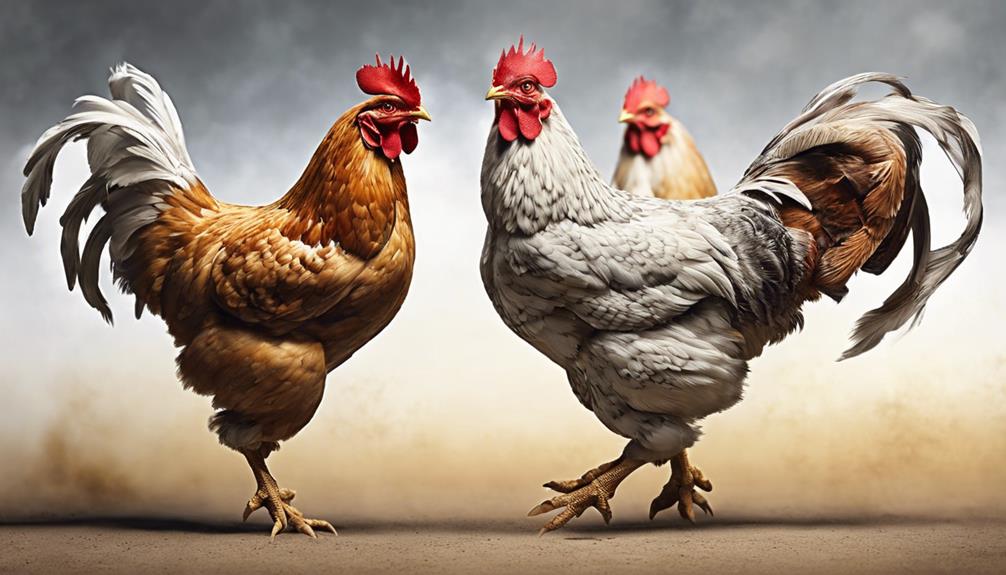
When comparing the jumping abilities of chickens, their breed and physical attributes significantly influence their vertical leap potential. Different breeds of chickens exhibit varying jumping capabilities, impacting their ability to achieve high jumps. For instance, bantam chickens, known for their small size and lightweight build, may not jump as high as heavier breeds like Orpingtons or Leghorns. In BYC contests, where chickens showcase their jumping prowess, breed selection plays a crucial role in determining the outcome.
In these contests, it's observed that certain breeds excel in vertical jumps while others might struggle to clear significant heights. Factors such as leg muscle strength, body weight distribution, and wing span also contribute to a chicken's jumping performance. Through careful breeding and selection, poultry enthusiasts can enhance specific jumping traits in their flock, aiming to produce chickens with impressive vertical leap abilities. Understanding the differences in jumping capabilities among various chicken breeds is essential for those looking to participate in or organize BYC contests focused on chicken jumping prowess.
Frequently Asked Questions
How High Can Chickens Jump to Roost?
Chickens can jump to roost at varying heights, with most reaching up to 4 feet effortlessly. Occasionally, some will strive for 6 feet, but very few can manage over 7 feet. Clipping flight feathers can deter excessive heights.
To maintain control, training with boundaries and providing suitable roosting areas are vital. Understanding these limits and implementing proper measures ensures chickens stay safe and comfortable while roosting.
How High Can Chickens Fly Vertically?
We know chickens can jump around 4 feet with ease, but heights of 6 feet are more challenging for them. Observations suggest that very few chickens can jump over 7 feet.
Clipping flight feathers can limit their vertical jumping ability, and training with boundaries like chicken wire can deter them from jumping higher. These methods are effective in managing and controlling the vertical jumping capabilities of chickens.
How High Can Chicken Jump With Clipped Wings?
When chickens have clipped wings, they can still jump surprisingly high, reaching up to 4 feet effortlessly. Even with this limitation, they remain adept jumpers. Proper training and enclosure design are crucial to preventing escape attempts.
However, clipping one wing may affect a chicken's balance, potentially impacting its jumping abilities. Understanding individual behaviors and breed variations is essential when considering the impact of wing clipping on jumping height.
How High Can Chickens Jump From?
We can observe chickens typically jumping from various heights, with most comfortably clearing around 4 feet. However, exceeding 6 feet presents a challenge for many chickens, with few able to surpass the 7-foot mark.
To limit their jumping abilities, clipping flight feathers can be effective. Additionally, training with boundaries like chicken wire can deter chickens from attempting high jumps. These methods help manage and control the jumping capabilities of chickens.
Is It Possible for Chickens to Die of Loneliness and How Can We Prevent It?
Chickens, like many social animals, can indeed suffer from loneliness. To prevent this, it’s essential to provide them with companionship and a suitable living environment. Introducing a few more chickens can alleviate their solitude and promote social interaction. Remember, understanding how to prevent rabbit loneliness can also be applied to ensuring the happiness and well-being of chickens.
Conclusion
In conclusion, the remarkable jumping abilities of chickens can be attributed to their unique anatomy, muscle strength, and specialized techniques. By understanding the science behind their impressive jumps, we can appreciate the incredible power and agility of these birds.
Just as chickens have mastered the art of high jumps, we too can strive for greatness by harnessing our own strengths and skills to reach new heights in our endeavors.
Dana is our Lead Content Writer, bringing a wealth of knowledge and expertise to our team. With a background deeply rooted in animal studies and a profound love for all creatures, Dana is dedicated to crafting engaging and informative content that resonates with our audience. With Dana at the helm, you can trust that our content is accurate and engaging, catering to the diverse interests of animal enthusiasts everywhere.
Chickens
Chickens Eat Red Cabbage: A Guide to Healthy Feeding
Discover why red cabbage is a fantastic choice for feeding chickens and how it can benefit their overall health and egg production.

When it comes to feeding chickens, red cabbage is an excellent option. It is rich in vitamins, minerals, and antioxidants that are essential for their overall health and egg production. Additionally, red cabbage is a good source of fiber which helps with digestion and promotes a healthy gut. It is important to rinse and chop the cabbage before giving it to your feathered companions, and remember to offer it in moderation to avoid any potential imbalances.
If you're curious about more vegetable options for your chickens, there's a whole list of nutritious treats waiting to be discovered!
Key Takeaways
- Offer red cabbage in moderation to maintain a balanced diet.
- Chop or shred red cabbage for easy consumption and digestion.
- Inspect red cabbage for quality and rinse to remove pesticides.
- Feed red cabbage once or twice a week as a healthy treat.
- Monitor chicken health and droppings when introducing red cabbage.
Benefits of Red Cabbage for Chickens
Red cabbage stands out as a nutritious addition to a chicken's diet due to its rich content of vitamins, minerals, and antioxidants essential for promoting optimal health and egg production. This vegetable is a powerhouse of vitamins A, C, and K, crucial for overall well-being and enhanced egg production in chickens. The presence of minerals such as calcium, iron, and potassium in red cabbage supports bone strength and metabolic functions, contributing to the chickens' vitality. Additionally, red cabbage provides antioxidants like anthocyanins, which play a vital role in boosting immune health and reducing inflammation in these birds.
Moreover, the high fiber content in red cabbage aids digestion and helps maintain a healthy gut environment in chickens. By incorporating red cabbage into their diet, chickens can experience enhanced nutritional diversity, leading to improved overall well-being and egg quality. This nutritional boost from red cabbage can significantly contribute to the vitality and productivity of your flock.
Safe Feeding Practices for Chickens
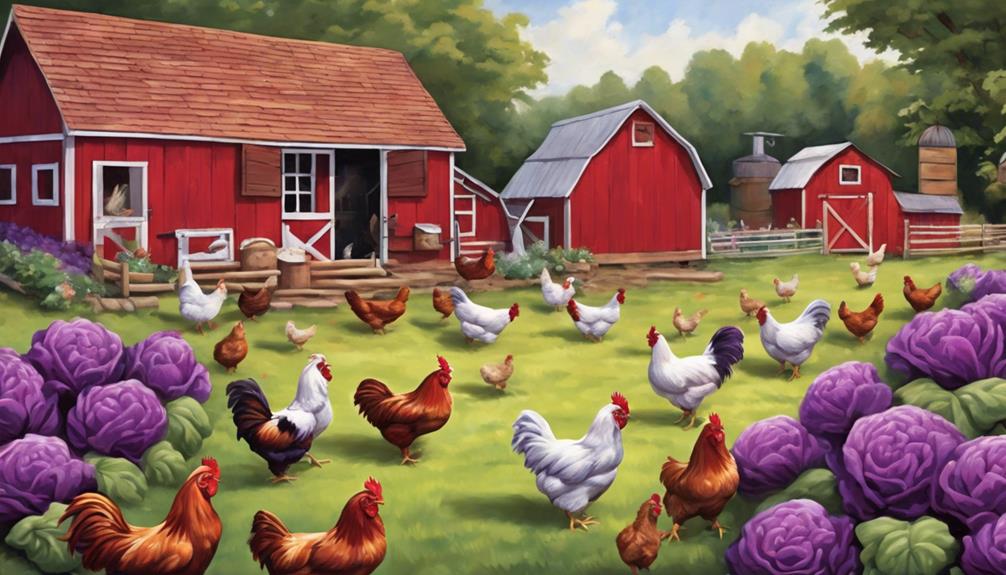
When feeding chickens cabbage, it's crucial to follow safe practices to ensure their well-being and digestive health. Start by rinsing and inspecting fresh cabbage to guarantee its quality and safety. Remove any moldy or rotten spots before offering it to the chickens to prevent potential health issues. Consider chopping the cabbage into small, manageable pieces to facilitate consumption and aid in digestion.
If you choose to feed cooked cabbage, you can provide it in larger pieces since the cooking process softens it, making it easier for the chickens to eat. It's important to remember to offer grit along with cabbage to the chickens. Grit helps in the digestion of fibrous foods like cabbage and prevents blockages in their digestive system.
Introducing Red Cabbage to Chickens
Inspecting red cabbage thoroughly before introducing it to chickens ensures their safety and well-being while providing a nutritious addition to their diet. Here are some key points to consider when introducing red cabbage to chickens:
- Nutrient-Rich: Red cabbage contains essential nutrients like vitamin A, which is crucial for chicken health.
- All Parts Consumable: Chickens can consume all parts of the red cabbage plant, including the roots, stalks, core, and leaves.
- Thorough Washing: It's important to wash red cabbage thoroughly to eliminate any pesticides present on the surface.
- Moderation is Key: Feed red cabbage to chickens in moderation to prevent nutritional imbalances and potential health issues.
Quantity and Frequency of Red Cabbage Feeding

To ensure optimal health and nutrition for chickens, carefully regulate the amount and frequency of red cabbage provided in their diet. Red cabbage should be fed to chickens in moderation, constituting no more than 10% of their overall diet to prevent any nutritional imbalances. This nutritious vegetable can be offered to chickens once or twice a week as a healthy treat, complementing their regular feed. It's essential to maintain a balanced diet for chickens, with 90% of their intake coming from their regular feed and the remaining 10% from treats like red cabbage to promote overall well-being.
When feeding red cabbage to chickens, ensure it's prepared in a way that facilitates easy consumption and digestion. Providing the cabbage shredded or chopped finely will make it easier for chickens to eat and digest. Monitoring the chickens' droppings and overall health upon introducing red cabbage to their diet is crucial to promptly identify any adverse reactions and adjust their consumption accordingly. By following these guidelines on quantity and frequency, chickens can enjoy the benefits of this nutritious vegetable as part of a balanced diet.
Other Recommended Vegetables for Chickens

Regulating the variety and quantity of vegetables in a chicken's diet is key to ensuring a balanced nutritional intake. When considering other recommended vegetables for chickens, one should focus on nutrient-rich options to promote optimal health. Here are four vegetables that can benefit chickens:
- Spinach: This leafy green is a powerhouse of nutrients, containing iron, vitamin A, vitamin K, and folate. These components support overall health and vitality in chickens.
- Radishes: Rich in vitamin C, potassium, and fiber, radishes offer a diverse array of essential nutrients for chickens, contributing to a well-rounded diet.
- Lettuce: With its high water content, fiber, and vitamins A and K, lettuce serves as a refreshing and hydrating snack for chickens, aiding in digestion and providing essential nutrients.
- Spaghetti Squash: Low in calories yet high in fiber and vitamin C, spaghetti squash is an excellent option for chickens seeking a nutritious treat that supports digestive health and immune function.
Incorporating these vegetables into a chicken's diet can enhance their overall well-being by providing essential vitamins, minerals, and fiber.
Frequently Asked Questions
What Is a Superfood for Chickens?
Red cabbage stands out as a superfood for chickens due to its exceptional nutrient profile. Packed with essential vitamins like A, C, and K, along with minerals such as calcium, iron, and potassium, it supports overall health and egg production.
The high fiber content aids digestion and promotes gut health. Including red cabbage in their diet enhances a chicken's nutrition plan, contributing to their well-being and vitality.
What Vegetables Cannot Be Fed to Chickens?
Vegetables that can't be fed to chickens include raw beans, processed foods like chips and candies, coffee and coffee grounds, avocado with its skin and pit, as well as onions and garlic. These items can be harmful to chickens due to toxins present in them.
It's crucial to avoid feeding these vegetables to ensure the health and well-being of our feathered friends.
What Is the Most Nutritious Food for Chickens?
When it comes to the most nutritious food for chickens, a balanced diet is key. Incorporating a variety of nutrient-rich foods like grains, seeds, fruits, and vegetables ensures they receive essential vitamins, minerals, and proteins.
Additionally, high-quality commercial feeds formulated specifically for chickens can provide a well-rounded nutritional profile. It's important to consult with a poultry nutritionist to tailor a diet that meets the specific needs of your flock for optimal health and productivity.
Is Lettuce and Cabbage Good for Chickens?
Yes, lettuce and cabbage are beneficial for chickens. They provide vital nutrients like vitamins, minerals, and fiber. The inclusion of these vegetables in their diet aids in digestion, hydration, and overall well-being.
Both raw and cooked forms can be fed to chickens for dietary variety and enrichment. Additionally, incorporating lettuce and cabbage supports egg production, feather health, and vitality within the flock when given in moderation.
Can Chickens Eat a Variety of Vegetables for a Balanced Diet?
Yes, feeding chickens spaghetti squash can be a great addition to their diet. Chickens can eat a variety of vegetables such as spinach, kale, carrots, and broccoli. These veggies provide essential nutrients and help create a balanced diet for your chickens.
Conclusion
In conclusion, feeding red cabbage to chickens can provide them with essential nutrients and antioxidants for overall health. Remember to gradually introduce this vegetable to their diet, monitor their intake, and balance it with other recommended vegetables.
By incorporating red cabbage into their feeding routine, you can ensure that your flock stays healthy and happy. So go ahead and let your chickens enjoy some 'hip' red cabbage to boost their well-being!
Dana is our Lead Content Writer, bringing a wealth of knowledge and expertise to our team. With a background deeply rooted in animal studies and a profound love for all creatures, Dana is dedicated to crafting engaging and informative content that resonates with our audience. With Dana at the helm, you can trust that our content is accurate and engaging, catering to the diverse interests of animal enthusiasts everywhere.
Chickens
How Chickens Can Safely Eat Slugs: A Complete Guide
Yearning to know if chickens can safely feast on slugs? Uncover the complete guide for vital insights and tips to keep your flock healthy.
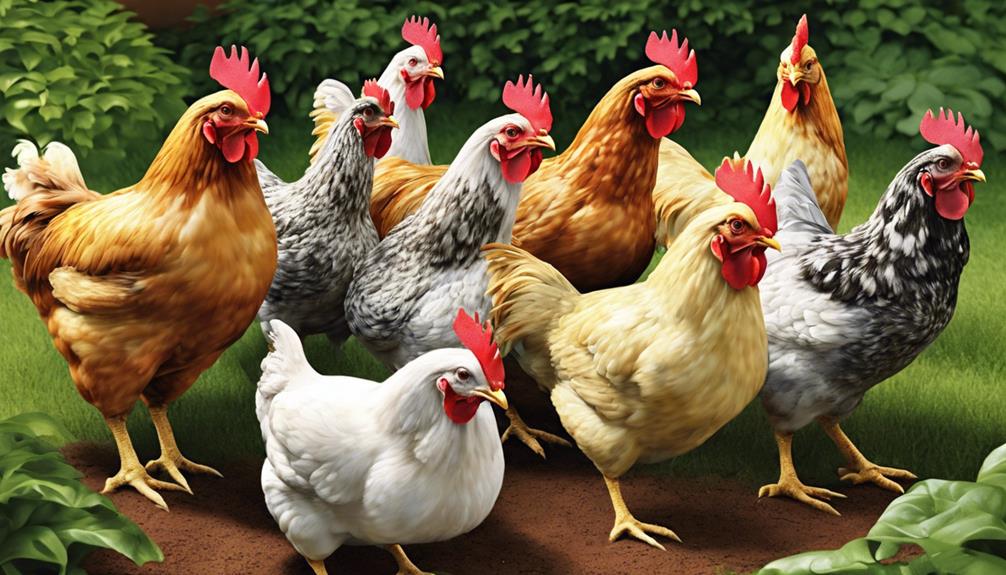
We have discovered that chickens can safely consume slugs from untreated areas when given in small quantities and observed for any negative responses. This natural supplement to their diet provides a valuable source of protein and fat, which could enhance their general health and immune systems. Be sure to seek advice from a veterinarian for guidance on the proper care and well-being of your chickens.
Further information on this topic can provide more insights into the benefits and risks associated with feeding slugs to chickens.
Key Takeaways
- Source slugs from untreated areas to avoid toxins and parasites.
- Start with small amounts and gradually increase to monitor reactions.
- Consult a vet before introducing slugs to chickens' diet.
- Benefits include protein intake, immune system enhancement, and diet diversification.
- Risks include respiratory issues, rat lungworm infections, and poisoning from pellets.
Identifying Safe Slugs for Chickens
When selecting slugs for chickens to eat, it's crucial to ensure they're from untreated areas to prevent potential harm from toxins or parasites. Chickens eat slugs as part of their natural foraging behavior, but not all slugs are safe for consumption. Some species of slugs can be toxic to chickens, causing harm to their health. It's essential to be cautious when allowing chickens to eat slugs and ensure that the slugs collected are from areas free of pesticides or chemicals that could be harmful to the chickens.
Furthermore, wild slugs may carry parasites that can pose health risks to chickens. These parasites can infect the chickens and lead to various health issues if ingested. Therefore, it's recommended to consult a vet before introducing slugs into the chickens' diet to ensure that it's safe for them to consume.
Additionally, when feeding chickens snails, it's important to cook them well to eliminate any harmful organisms that they may contain. Taking these precautions can help maintain the health and well-being of the chickens when they eat slugs.
Introducing Slugs Into Chickens' Diet
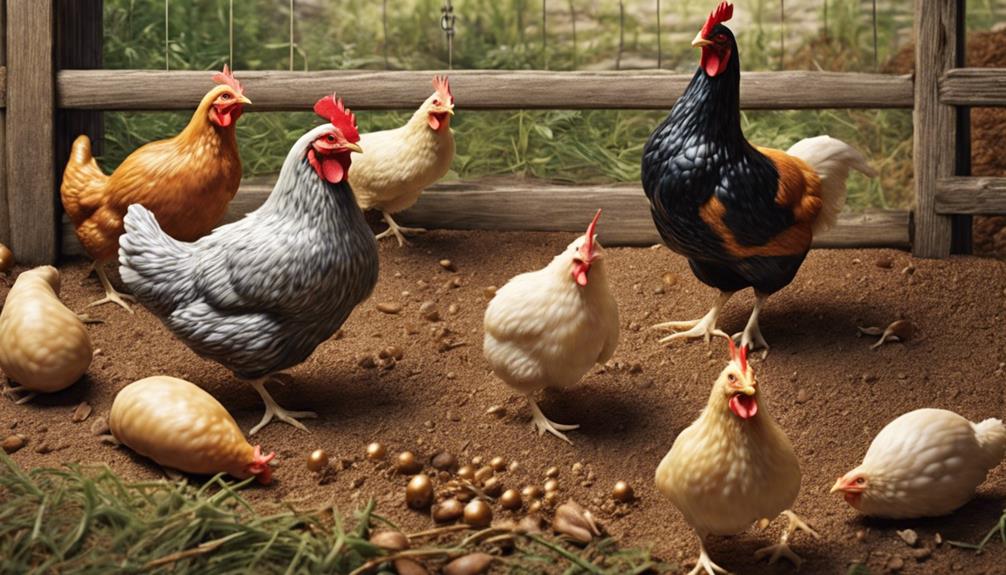
To successfully introduce slugs into chickens' diets, it's essential to monitor their response gradually and watch for any adverse reactions or digestive issues. When incorporating slugs into the chicken coop, follow these key steps:
- Gradual Introduction: Start by offering small amounts of slugs to the chickens and gradually increase the quantity over time. This helps the chickens adjust to this new food source without overwhelming their digestive system.
- Monitoring Behavior: Keep a close eye on the chickens after introducing slugs. Watch for any changes in their behavior, such as reduced egg production or unusual lethargy, which could indicate a negative reaction to the slugs.
- Health Assessment: Regularly assess the overall health of the flock when slugs are part of their diet. Check for any signs of digestive issues or discomfort, and consult a veterinarian if any concerns arise.
Benefits of Chickens Eating Slugs
After gradually introducing slugs into chickens' diets and monitoring their response, it becomes evident that the benefits of chickens eating snails are multifaceted and significant for their overall health and well-being. Chickens benefit from consuming snails as they offer a rich source of protein and fat, essential for their balanced diet.
Snails can serve as a natural treat for chickens, contributing to their nutritional intake and overall vitality. By eating snails, chickens can diversify their diet, which, in turn, enhances their immune systems and well-being. When collected from untreated areas to prevent contamination with harmful chemicals, snails can be a safe and valuable addition to chickens' nutrition.
Moderation is key when offering snails to chickens, ensuring they receive the nutritional advantages without overindulging. With a wide variety of nutrients that snails provide, incorporating them into chickens' diets can positively affect chickens' health and happiness.
Risks Associated With Chickens Eating Slugs
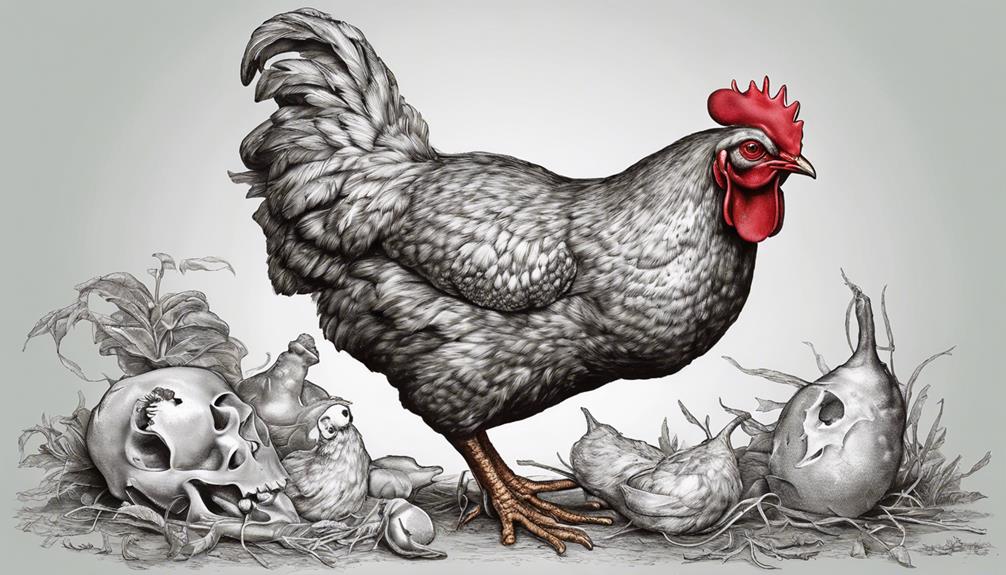
While chickens benefit from consuming slugs in their diet, it's crucial to be aware of the potential risks associated with this practice. Chickens can contract gapeworm from slugs, leading to respiratory issues and potential death. Additionally, rat lungworm, another parasite, can infect chickens through slugs that have consumed infected rat droppings. Symptoms of gapeworm and lungworm infections include lethargy, breathing difficulties, and loss of appetite in chickens.
Regular deworming of chickens is essential to reduce the risk of infections from slugs and snails.
Poison pellets used to kill snails can be harmful to chickens if ingested, posing a danger to their health.
Monitoring the health and behavior of chickens that have access to slugs can help in early detection of any potential issues and prompt treatment.
Best Practices for Feeding Chickens Slugs

Moving from the risks associated with chickens eating slugs, a key aspect to consider is implementing best practices for feeding chickens these creatures to ensure their well-being and health. When it comes to incorporating slugs into your chickens' diet, moderation is crucial. Offering slugs as occasional treats can provide a diverse range of nutrients and contribute to boosting their immune systems. However, overfeeding slugs to chickens can lead to digestive issues, so it's important to limit their consumption.
Before introducing slugs into your chickens' diet, it is advisable to consult a veterinarian. A professional opinion can help ensure that the slugs are safe for consumption and provide nutritional benefits to your flock. Additionally, collecting slugs from untreated areas is essential to prevent contamination with harmful chemicals that could harm your chickens.
Below is a table summarizing the best practices for feeding chickens slugs:
| Best Practices for Feeding Chickens Slugs | |
|---|---|
| Feed in Moderation | Collect from Untreated Areas |
| Consult a Veterinarian | Ensure Nutritional Benefits |
Frequently Asked Questions
How Do You Eat Slugs Safely?
We eat slugs safely by ensuring we source them from untreated areas and avoid toxic species. Moderation is key, as these can be beneficial protein sources when fed appropriately. It's crucial to consult a vet before introducing them into our diet for safety.
Cooking snails thoroughly is essential, providing us with protein and calcium benefits. By following these guidelines, we can enjoy slugs as occasional treats while keeping our health in check.
Is Sluggo Safe for Chickens?
Yes, Sluggo is safe for chickens. It contains iron phosphate, a non-toxic substance that poses no harm to poultry if ingested.
Unlike metaldehyde-based baits, Sluggo is safe for chickens even if they consume treated slugs. This bait is approved for organic gardening and is considered safe for pets and wildlife.
Using Sluggo around chicken enclosures can help control slugs and snails without endangering the birds.
Can Chickens Eat Beer Soaked Slugs?
Yes, chickens can eat beer soaked slugs, but moderation is crucial. Chickens may find the scent and taste of beer soaked slugs enticing. However, it's important to offer this as an occasional treat rather than a regular part of their diet.
Monitoring the chickens after consuming beer soaked slugs can help ensure their health and well-being. The alcohol content in the slugs is minimal after being eaten by the chickens.
Can Chickens Get Worms From Slugs?
Yes, chickens can get worms from slugs. Gapeworm, a red parasite that infects a chicken's respiratory system, can be transmitted through slug consumption. Symptoms include lethargy, difficulty breathing, and loss of appetite. Deworming with medications like Flubenol and Aviverm can treat gapeworm infections.
While less common, chickens can also contract gapeworm from eating snails. Avoid feeding chickens poison pellets used to kill snails, as they can harm the birds if ingested.
Is it Safe for Chickens to Eat a Variety of Foods, Including Slugs and Raw Asparagus?
Yes, chickens eating raw asparagus expert agree that a variety of foods, including slugs and raw asparagus, can be safely incorporated into their diet. Asparagus provides essential nutrients, while slugs are a natural source of protein. However, moderation and variety are key to a balanced and healthy diet for chickens.
Conclusion
In conclusion, feeding chickens slugs can be a beneficial addition to their diet, as long as precautions are taken to ensure the safety of the slugs. Remember, not all slugs are created equal, so it's important to identify safe options for your flock.
By following best practices and monitoring their intake, you can turn your chickens into slug-eating machines, helping to keep your garden pest-free. It's like having tiny, feathered pest control experts roaming your yard.
Dana is our Lead Content Writer, bringing a wealth of knowledge and expertise to our team. With a background deeply rooted in animal studies and a profound love for all creatures, Dana is dedicated to crafting engaging and informative content that resonates with our audience. With Dana at the helm, you can trust that our content is accurate and engaging, catering to the diverse interests of animal enthusiasts everywhere.
-

 Vetted2 months ago
Vetted2 months ago15 Best Cat Foods for Managing Hyperthyroidism – Vet Approved and Feline Friendly
-

 Vetted2 months ago
Vetted2 months ago15 Best Dog Foods for Kidney Disease – Expert Recommendations for Your Pet's Health
-

 Vetted2 months ago
Vetted2 months ago15 Best Fresh Dog Food Delivery Services for Your Pup's Health and Happiness
-

 Animal Facts2 months ago
Animal Facts2 months agoSpring Animals: A Guide to Seasonal Wildlife
-

 Cats6 days ago
Cats6 days agoTop 5 Cat Breeders in Arkansas: A Guide
-

 Cats1 month ago
Cats1 month agoCat Weight Chart by Age: Kitten to Senior in Lbs
-
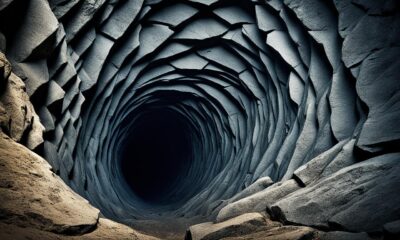
 Rabbits2 months ago
Rabbits2 months agoExploring Rabbit Holes: What Do They Look Like?
-
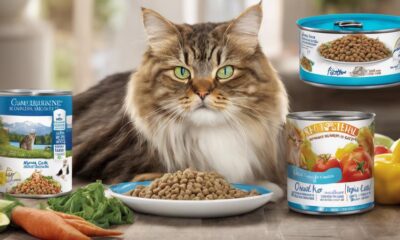
 Vetted2 months ago
Vetted2 months ago15 Best Wet Cat Foods for Older Cats to Keep Them Healthy and Happy




















